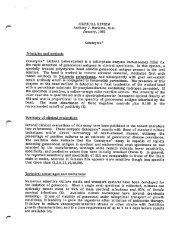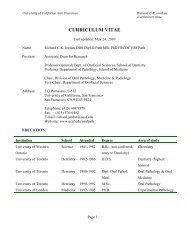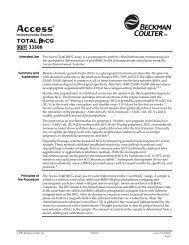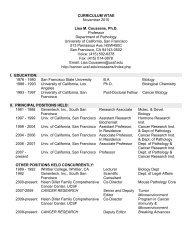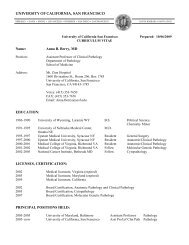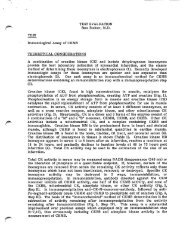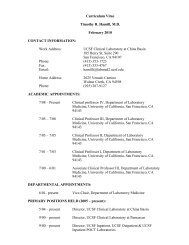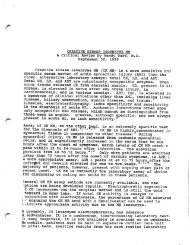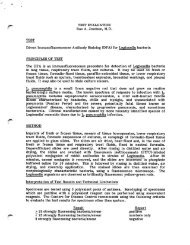Myelodysplastic Syndromes
Myelodysplastic Syndromes
Myelodysplastic Syndromes
You also want an ePaper? Increase the reach of your titles
YUMPU automatically turns print PDFs into web optimized ePapers that Google loves.
<strong>Myelodysplastic</strong> Syndrome<br />
• Incidence of 3-5/100,000 with male<br />
predominance<br />
• Occurs primarily in older adults with<br />
median age of ~70 years<br />
• ~10,000 new MDS cases diagnosed<br />
annually in the United States<br />
• Many of us encounter bone marrow<br />
evaluations to “rule out” MDS in cytopenic<br />
patients! (if only it were that easy….)<br />
MDS Challenges<br />
• Dysplasia is required for diagnosis but is<br />
not specific…..<br />
– Requires careful correlation with clinical<br />
information to exclude non-neoplastic causes:<br />
• Medications/chemotherapy • Toxin exposure<br />
• Nutritional status • Cytokine therapy (G-CSF)<br />
• Infections, including HIV • Congenital conditions<br />
• Autoimmune conditions<br />
– If unilineage dysplasia and absence of a<br />
clonal cytogenetic abnormality, 6 month<br />
observation is recommended by WHO before<br />
a definitive diagnosis of MDS<br />
<strong>Myelodysplastic</strong> Syndrome<br />
• Diagnostic features:<br />
– Morphologic dysplasia : at least 10% of cells in<br />
one or more lineages, ring sideroblasts<br />
– Clonal cytogenetic abnormality (50% of cases)<br />
• can be used as presumptive evidence of MDS if<br />
dysplasia lacking<br />
– Increased blasts (if not on G-CSF)<br />
• Other causes of dysplasia should be excluded<br />
(especially if a cytogenetic abnormality is lacking)<br />
MDS Challenges<br />
• MDS may lack sufficient morphologic<br />
dysplasia to allow definitive diagnosis<br />
– Defined cytogenetic abnormalities provide<br />
presumptive evidence of MDS; patients should be<br />
monitored for emerging morphologic evidence of MDS<br />
– Some lack dysplasia and cytogenetic abnormality at<br />
initial presentation; continued monitoring and repeat<br />
evaluation may be required<br />
• “idiopathic cytopenia of undetermined significance”<br />
(does not meet minimal criteria for MDS by WHO)<br />
• Cytogenetic abnormalities seen in other<br />
disorders (e.g. aplastic anemia)<br />
2





